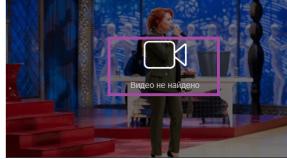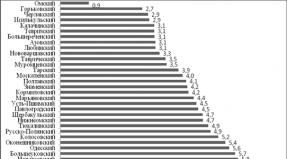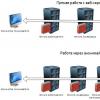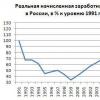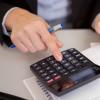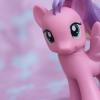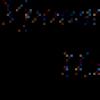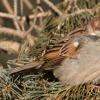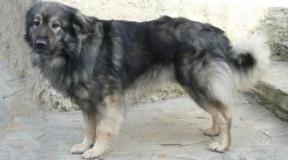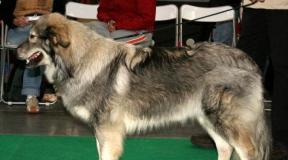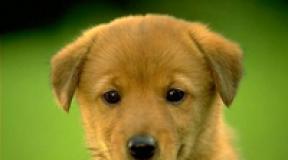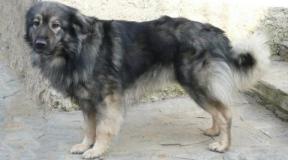What is a mathematical dictation. Mathematical dictations in mathematics. Methods for conducting dictation
Mathematical dictations given in this manual are diverse:
- dictates, some of which are theoretical questions, and some are the simplest practical tasks on the relevant topic that do not require large records;
- dictations, fully consisting of practical tasks, similar to the tasks of the textbook, which are performed almost orally, it is only required to write the answer;
The use of mathematical dictations does not solve all the problems facing the teacher, but significantly helps him in work. Before proceeding to the study of a new material, the teacher needs to make sure that previous knowledge of students learned. Inscribe the whole class in the lesson is not real. If you interview multiple students at the board, then, as a rule, the rest listened to inattentive. With the help of a dictation, you can find out the level of assimilation of the previously studied material in the whole class. Dictates can be used immediately after the explanation of the new material so that students are better learned. You can effectively use dictations in the lessons of generalization and systematization of knowledge. In addition, pronigrating the same material many times allows even "weak" to learn the mandatory minimum content in mathematics.
Semenyuk Natalia Vyacheslavovna, 14.11.2017
2314 277
Development content
Algebra Grade 7.
Topic 1. Degree with natural and integer indicators.
Dictation 1. Degree with a natural figure.
1. Sign in the form of the work the third [fifth] degree of number 5 and find its value.
2. What is the first degree of number -6?
3. Calculate the value of the expression 2 2. 2 3.
4. What is the amount of cubes [square difference] numbers 6 and 3?
5. Calculate the square of the number 4 cube [Cube of the number of numbers 2].
Dictation 2. Properties of the degree with a natural indicator
1. Express expressions A 8. A 5 [from 5. from 7]. Imagine this expression in the form of degree.
2. Write the degree that will turn out if the expression X 2 [A 2] is erected into the fourth [third] degree.
3. Implement in the form of a work of degrees the second [third] degree of product of numbers 7 and 13.
4. Follow in the form of degree expression 3 13 * 9 13.
5. Implement in the form of the degree of number 5 Private 5 80: 5 40.
6.And a negative. What is the sign of the number and 18? [The number B is negative. What is the number of B 19?]
Dictation 3. Integer
1. Give the determination of the zero degree number.
2. Express expression 5 4, 7 0, 2 -3 and find their values.
3. Implement a fraction in the form of a degree with a negative indicator.
4. Write the expression x -5 * x 7 [A 8 * A -10]. Imagine it in the form of degree.
5. Find the extent to which it turns out if the expression X -5 [y -7] is erected in minus the fourth degree.
6. For what x, y, and it's right that and x: and y \u003d and x - y?
Dictation 4. Standard view of a member
1. Release in standard form number 582.7.
2. Write in standard form number 0.54.
3. How does a standard view of 3.5 * 10 -5?
4. What is the standard view - 3.001 * 10 5 [-4.006 * 10 -2]?
5. Another works of numbers 3 * 10 -7 * 5 * 10 2 [4 * 10 3 * 6 * 10 -5] and write it down in standard form.
Dictation 5. functions y \u003d ah 3 and y \u003d ah 2
Donated points M (-3; -9); A (2; 4) [c (-13; 169); K (5; 10)] Determine through which of these points the function graph passes: y \u003d x 2?
Which of the following points belong, and which does not belong to the graphics of the function
y \u003d x 3 V (-2; -8); K (1; 3) [P (-4; 64); E (5; 125)]
How the square of the square changes, if the side is to increase 2 times [decrease 4 times].
Dana function y \u003d -4x 3. Find: function value for all x \u003d -1 [x \u003d 0.5].
Dictation 6. function y \u003d and its schedule
1. Does the graph of the function y \u003d points A (-3.6; -2) [C (0.04; 1800)]
2. In which coordinate corners there is a graph of the function: y \u003d [y \u003d]
3. Due to the function y \u003d. Specify the set of values \u200b\u200bof the variable x, in which the function accepts: positive values \u200b\u200b[negative values].
4. Allow the sign of the number K knowing that the function y \u003d is located: in 1 and 3 coordinate quarters [in 2 and 4-order quarters].
Topic 2. Single and polynomial.
Dictation 1. Singoral
Is a single expression of 15x 2 y. If so, what is its coefficient and what is his degree?
Build a square [in cube] Single-4h 5 [-8ab 3]
Record in the form of a standard type of design of single-wing 4a 3 BX and -8Ash 2.
Dictation 2. polynomial. The amount of polynomials.
What is the name of the amount of one-pans?
Write down some triplee [four items].
Record the polynomial A - 2A + 2A * A 2 - 5 + 1 Bring it to the standard form.
Formulate the rule of addition of polynomials. Give an example.
Complete equality: A 2 - 7A + 5 \u003d A 2 - (...... ..) [x 6 - 6x + 2 \u003d x 2 - (.......)].
Dictation 3. Multiplication of the polynomial per single.
Write the same names, obtained by multiplying in 2 per each of the members of the polynomial 2-1-4U 2 + 6 [x 3 - 3x +5].
Multiply a polynomial 5x - 2y on single-wing - x 2 [-2b 2]
Decide equation 3x (x - 2) + 3x (6 - x) \u003d 0.
Multiply single-wing 3a 2 x [-6by 2] on a polynomial -4ach 2 + x 3
Multiply a polynomial A 2 - AB + B 2 [x 2 + Hy + in 2] on a single-stranded -4Ab.
Dictation 4. Multiplication of polynomials.
Write the polynomials that are obtained if each member of the polynomial 7x - 2 multiply to each member of the polynomial 5 - 6x 2.
Multiply the polynomial X + 4 [x - 3] on the polynomial x - 3 [x + 3].
Present in the form of a polynomial of the standard view of the square of twisted
x - 3ow [a - 2b].
Prepare the standard of the standard type of twisted x - y [a + b] and three-shredd x 2 + hyd + y 2 [A 2 - AB + B 2].
Multiply the polynomial x - y [a + b] on the polynomial x + y.
Dictation 5. Making a common factor for brackets.
1. What is the degree of a multiplier and can be reached by brackets in a polynomial A 2 x - A 5 x
2. How the numerical factor can be reached by brackets at the polynomial 12x 2 - 6x 2
3. Make a general factor of all members of the polynomial A 2 + AB-AC + A.
4. Implement in the form of a product of a polynomial 3x + hu
Dictation 6. Method of grouping.
1. Indicate the expression: 3 (A + 2B) - A (A + 2B); .
2. Indicatrate expression: 7x -7Y + A (Y -X); .
3. Purpose polynomials: 3C 2 + 15AC - 2C - 10A; ;
4. Purpose polynomials: A 3 + 3A 2 B + AB 2 + 3B 3; ;
Topic 3. Formulas of abbreviated multiplication.
Dictation 1. The difference of squares of two expressions.
1. Production of the difference of two expressions and their sum is ...?
[The difference of squares of two expressions is equal ...?]
2. Spread on multipliers: x 3 - 25x; ;
3. Simplify the expression: (3 + 5ab) (3 - 5ab); [(2a - 3b) (3b + 2a)];
4. Decide the equation: T 2 - 25 \u003d 0; ;
5. Calculate with the help of formula: 55 2 - 45 2; ;
Dictation 2. Square amounts and square of the difference of 2 expressions.
1. Between the sum of two expressions is equal ...? [Square of the difference of two expressions ...];
2. Prepare a polynomial: (A -5) 2; [(2a + 4c) 2];
3. Prepare the following three-meters in the form of squares of bounce: A 2 + 4C 2 -4AC;
4. Simplify the expressions: (B +1) 2 -5B; [(a +2) 2 -4a];
5. Find the values \u200b\u200bof the expressions: B 2 -2B +1, at b \u003d 21; ;
Dictation 3. Cuba The sum and cube of the difference of 2 expressions.
1. Formula cube difference of 2 expressions is determined by the formula ......
(Cuba formula 2 expressions is determined by the formula: ... ..)
2. Find the Cube of the sum of 2 expressions: 4A and 7B.
3.Name Cube of the difference of 2 expressions. 6x and 3y.
4. Prepare in the form of polynomials: (3m -2n) 3 [(4Y -3) 3].
Dictation 4. Formulas Amounts and Differences Cuba 2 h. expressions.
1. And is it equal to the amount of cubes 2 x expressions? [What is the difference in cubes of 2 x expressions]?
2. Spread on multiplied: 1 + 64n 3.
3. Simplify the expression (M -2N 2) (m 2 + 2mn 2 + 4N 2). [(16x 2 + 4AX + A 2) (4x -A)].
4. Speak that, 75 3 +65 3 divide 700.
Theme 4. rational fractions.
Dictation 1. rational fraction. Reducing rational fraction.
1. Clean the permissible value of variables in the expression:
2. Give a fraction to the denominator: 3AD; -AD.
3.C Obtain fraction:
Dictation 2. Addition and subtraction of algebraic fractions.
1. Fold the fractions: and ![]() .
.
2. Fill the subtraction of fractions: ![]() and
and
3. Give to the general denomoter: and
4.C Log in: ![]()
5. Implement in the form of a fraction Expression: ![]()
Dictation 3.Maluction and division of algebraic fractions.
1. Imagine the fracted expression: ![]()
![]()
2. Imagine fractions fifth degree of fractions: ![]() .
.
3. Prepare the fracted expression: (a + x) · ![]()
4. Imagine the fraction in the form of degree: ![]()
5. Provide in the form of a piece of work from dividing fractions: ![]()
6. Present in the form of a fraction private from dividing fractions:
Topic 5. Elements of approximate calculation.
Dictation 1. Measurement of values. The approximate value of the number. Absolute error.
1. round number 7.827 to tenths ![]() And find the absolute error of the resulting approximate value.
And find the absolute error of the resulting approximate value.
2. Round the number of 6,435 hundred hundredths and find the absolute error of the resulting approximate value.
3. 9.61. The student found that approximately 9.6. What is the absolute error of this approximation?
[What accuracy can be measured with a liquid with a liter mug?]
4.7 is approximately 8.37. What is the greatest possible value of the absolute error of this approximation?
[Equally 13.69. The student found that approximately 13.7. What is the absolute error of this approximation?]
5. C What accuracy can be measured by weight kilogram weights? [Number approximately 3.912. What are the most possible values \u200b\u200bof the absolute error of this approximation?]
6. What is the accuracy of measurements with a line with millimeter divisions [transporter with degree divisions?]
7. Circuit number 0.275 to tenths [hundredths] and find the relative error of the obtained approximate value.
Geometry class 7
Topic 1. Initial geometrical information.
Dictation 1. Basic concepts of geometry. Section. Ray.
Picture and mark the point C. [Call some geometric shape].
Draw and designate straight a. [Picture and designate the point A].
Distribute and mark the direct α. [Name some geometric shape].
How many dot points have two intersecting straight lines? [How many common points have two non-rigging straight lines?]
How many common points have two intersecting [non-intersecting] straight lines?
Can two different directs have two common points m and k?
Straight B passes through the point E and does not pass through the d d. Which of these points lies on a straight line b [a]?
Draw two straight lines intersecting at point n.
Point P and K lie on one straight line. Write down how you can designate this straight.
Point C lies on the segment of the Republic of Moldova [Sun]. Which of the points C, P and M [A, B and C] lies between two other points?
Cut XY crosses direct A [C], and the segment of Hmm [AS] does not cross this straight. Is it crosses direct a [s] segment Y m [Sun]?
The point C [A] lies on the ray AV [Sun]. How else can you call this ray?
Dictation 2. Corner. Bisector corner.
Dictation 3. Concept of definitions, axioms, theorems.
What are the main properties of the simplest geometric figures taken without proof? [What is the name of the reasoning showing the correctness of any geometric statement?].
Write the word "definition". [What is the name of the geometrical statement, the correctness of which is established by proof?].
What is the reasoning the reasoning showing the correctness of any geometric statement? [What are the main properties of the simplest geometric figures taken without proof?].
What is the name of the geometrical statement, the correctness of which is established by proof? [Write the word "definition"].
What: an axiom, theorem or definition - is the proposal: "Two straight ones are called parallel, if they do not intersect"? [What is the name of the part of the formulation of the theorem, which says that it is given?].
What: an axiom, theorem or definition - is the proposal: "Direct, crossing one of two parallel straight lines, crosses and second"? [What is the name of the formulation of the theorem, which states that should be proven?].
What: an axiom, theorem or definition - is the proposal: "After a point that does not lie on this line can be carried out on the plane of no more than one straight, parallel to this"? ["Two straight ones are called parallel if they do not intersect"]?
Dictation 4. Related and vertical angles.
What is the angle, adjacent to direct angle? [One of the adjacent angles is straight. What is the second angle?].
The sum of two angles with general side is 180 0. [The sum of two angles is 180 0.] Do these angles are required?
Finish the proposal: "If the angles of 1 and 2 adjacent, then their amount ...". ["Two angles are called adjacent if one side is common, and the other two ..."].
Finish the proposal: "Two angles are called adjacent if one side is common, and the other two ...". ["If the angles of 1 and 2 adjacent, then their sum ..."].
One of the four angles that obtained with the intersection of two straight lines is 130 0. What are the remaining corners?
Two angle with a total vertex is equal [not equal]. Do they have vertical? [Are they vertical?].
Two angles are a common top. The first angle is 60 0, the second 120 0. Are these corners vertical? [What is the angle, if the angle vertical with it is 130 0?].
Topic 2. Mutual location of direct.
Dictation 1. Parallel straight. Signs of parallel straight lines.
Draw two parallel direct speakers and RK. [What is the name of two straight lies lying in the same plane and do not have common points?].
Write down using characters: direct AC and MV [CT and HP] are parallel.
Finish the proposal: "If direct but parallel to direct b, and straight b. Parallel direct from, then ... "[" Two straight, parallel to the third, ... "].
What angles are called external passages lying? [What angles are called internal clocks lying?].
Internal unilateral angles in the amount are 180 0, and one of the internal stakes of the lying angles is 45 0. What is the second one from the internal passage of lying angles? [What is the sum of the internal one-sided angles, if the internal passage of the underlying corners are equal?].
Look at the desk. And parallel to, angle 1 is 70 0 [Angle 2 is 110 0]. Find all other corners formed when crossing two parallel straight line.
Dictation 2. intersecting straight. Perpendicular and oblique.
What are the direct are called intersecting? [Perpendicular].
Dana straight a and point with belonging to A, in non-belonging. Spend a straight in, perpendicular to the direct A, passing through the point with [via the point in] using a drawing triangle.
Definition perpendicular [inclined] to a straight line.
What kind of an angle is the man who stands in the ranks, with the teams: "On the right" ["on the left"]?
Draw a stupid QA Angle. Through the top of the angle, the perpendicular direct to the rays of Ca [SV].
Topic 3. Triangles.
Dictation 1. Triangles and its views.
Speak the parties [the vertex] of the AOS triangle.
Name the types of triangles along the length of the parties [by the magnitude of the angles].
Build an equilateral triangle [an equilibried triangle].
Can there be two stupid angle [two straight corners] in a triangle. Justify the answer.
Find the sides of the equilateral triangle if its perimeter is 30cm.
Find the third side of an equifiable triangle, if two sides are known: 5 cm and 6cm.
Find the perimeter of the triangle, if the length of its sides is known 15cm, 14cm, 5 cm.
Dictation 2. The sum of the internal and external corners of the triangle.
How much in the triangle of external angles [internal angles]?
Are there triangles with angles 30 0, 20 0, 120 0?
Find the third angle of the triangle in two data corners: 39 0, 50 0.
Find an external angle at the top of A [at the top of the V]. If angle A is equal to 30 0, the angle is equal to 90 0, the angle C is 60 0.
Dictation 3. Equality of triangles.
Formulate the first [second] sign of the equality of the triangle.
Finish the proposal: "In the triangles of RQR and CST, the part of the PR is equal to CT, the QR side
equal to ST. What else should be done so that these triangles turn out to be equal to the first character? " ["The first sign of the equality of triangles is a sign of equality by ..."].
In the Triangles MPQ and LKT, the angles [side] M and Q [CD] are equal to [equal to], respectively, the angles [side] L and T [RK, the angle D is equal to the angle]. What else should be done so that these triangles turn out to be equal on the second basis?
In the triangles of Breeding and May, the parties are equal to the sides of the ACM and AC and AE and the side of the AC and cm and cm equal to the parties of the vessel and the EC.] Do these triangles be equal?
Dictation 4. Properties of an isced triangle.
Finish the proposal: "In an anoseced triangle corners ..." ["Median, conducted to the ground ..."].
In an equilibried triangle, a segment is taken connecting the vertex with a point lying on the base. This segment is not a median [height] of this triangle. Can he be his bisector [median]?
The side of the AC is the foundation of an equifiable triangle ABC, VM - its height [Median]. ABS angle is 68 0. It is equal to the angle of HBM [NMS].
In an equilibried triangle XYT side XY - the basis of [Parties of MR and RK - side sides]. What angles in this triangle are equal?
In the triangle, not one of the heights [Median] does not coincide with any bisector. Is it an equilibried triangle?
Dictation 5. Rectangular triangles.
Finish the proposal: "What is the name of a triangle that has angle 90 0?" ["The triangle who has a straight corner is called ..."].
Finish the proposal: "The side of a rectangular triangle, adjacent to the direct [opposite direct] corner called ...".
In the triangle MNK corner M - straight. What is in this triangle segment NK, cathelet or hypotenurus.
Hypotenuses of two rectangular triangles are equal. One of the angles of the first triangle is 50 0, and one of the angles of the second - 70 0. Are these triangles equal?
One of the angles adjacent to the cathelet of the rectangular triangle is 50 0. What is the second angle, sticking to the same cathelet? [One of the corners of the rectangular triangle, adjacent to the hypotenuse, is 50 0. What is the second angle, adjacent to the hypotenuse?].
In a rectangular triangle, one of the corners is 48 0. What are the two other corners are equal?
Topic 4. Circle. Geometric construction.
Dictation 1. Circle and its elements. Central angles.
Finish the proposal: "Many points of the plane, equally removed from this point ..." ["Chord, passing through the center of the circle ..."].
What is the segment connecting two circumference points [point of the circle with its center]?
Give the determination of the central angle [chords].
Find the length of the circle radius, if the length of the diameter is 160 mm.
Find the length of the circle diameter, if the radius length is 42cm.
Draw a circle of the radius of which is 3 cm. Spend chord the AU [Diameter VM].
Find the angular measure of the arc if the degree of the corresponding central angle of the corresponding central angle is 48 0.
Dictation 2. Mutual arrangement of direct and circumference. Mutual arrangement of two circles.
1. Give the definition of the sequential [tangent].
2. Build a tangent [secure] to the circumference.
3. What concern is called internal [external]? Give an example.
4. Install the mutual arrangement of the circle if R is 5 cm, R is 3 cm; Oo 1 \u003d 7cm.
Dictation 3. Circle described near the triangle. Circle inscribed in a triangle.
1. Finish the proposal: "If the circle is inscribed in a triangle, then it ..." ["If the circumference concerns all sides of the triangle, then it ..."].
2. Finish the proposal: "If the circle concerns all sides of the triangle, then this triangle is called ..." ["If the triangle is described near the circumference, then this circle ..."].
3. Dana County. Draw an arbitrary triangle inscribed [described] into this circumference.
4. The circle with the center O is described near the triangle of the MRA. Cut MO is 9cm. What is the segment of RO?
Preface ..............................................................................
7th grade. Algebra
Theme 1 degree with natural and integer indicators ..................... ...
Topic 2 Single and polynomial .....................................................................
Theme 3 formulas of abbreviated multiplication ............................................
Theme 4 rational fractions ....................................................... ... ..
Topic 5 Elements of approximated calculation ................................. .....
7th grade. Geometry
Topic 1 Primary geometrical information .......................................
Topic 2 Mutual location ......................................................
Theme 3 triangles ....................................................................................
Topic 4 Circle. Geometric constructions .............................. ...
Preface
Mathematical dictations are a well-known form of knowledge control. They are used on my lessons once a week, thereby trying to diversify learning methods. Dictates do not include a specific topic. I called them "dictations - Vigretiki", i.e. They are examples, rules, formulas from different topics that need to be recorded or answering orally at any time and at any lesson. Such dictations can be made up of 7-10 questions. It depends on class performance. You can conduct them instead of an oral account. After another check of the dictation, if the teacher sees that most students on this or that question is poorly answered, it can be repeated in another dictation.
Students will learn to listen to the teacher who changes the intonation in the process of conducting a dictation. The auditory channel of information is also like a visual takes one of the first places. Therefore, our students need to develop it.
Such types of dictation can be from grade 1 to grade 11. Believe me, the result will be. The teacher is very difficult to carry out dictations in two options, as it is necessary to read the text of the tasks at a certain pace, follow the class, respond to the inevitable questions of students: "Repeat", "my handle does not write", etc.
Every question is read three times:
- students listened;
- write the answer to the question;
- check what they wrote.
At the end of the dictation, we collect leaves (element leaves), on which the work was performed and in the next lesson I declare the result. Disassemble errors. You can, if it allows the lesson time, the answers to show on an interactive blackboard. In this case, at the beginning of the dictation, students are warned that corrections in dictation are not allowed. Such a check of a dictation allows you to immediately discuss the questions that caused difficulties or will allow better learning the material of the lesson. Dictage checks not the promotion of students, but their knowledge. If the dictation is required when answering the drawing, it is allowed to draw it from hand with a handle.
But it is still necessary to take into account that with the help of such dictations, students will digest a mandatory minimum of knowledge, but it is impossible to organize an in-depth check. In mathematical dictations, control can only be conducted by the final result.
If there are some comments, you can write to the mail [Email Protected]
I wish you success!
Examples of texts and answers of mathematical dictations
Dictation 1 for grade 5
Answers to dictation 1 for grade 5.
1. 1,3,5,7,9.
2. P. \u003d 4 · a. (Figure Square Side a.)
P.- perimeter, a. - side of a square
5. 345, 670,215.
7. t \u003d S: V
t - Time
S - Distance (Path)
v - speed
8. 2 800 348 005
Dictation 2 for grade 5
Answers to dictation 2 for grade 5.
3. (drawing of a rectangle with sides a, B.)
S - Square
a - Length
b - width
7. 
Dictation 1 by algebra for grade 8
1. Record the formula that expresses inversely proportional
function. What is a graph of this function.
2. Record the sum and the difference of cubes.
3. Simplify the expression:
4. Imagine in the form of a degree:
5. What is the name of the function what is equal to the angular coefficient of this function?
6. Record the formula to calculate the perimeter of the rectangle.
7. Prepare the fracted expression:
Answers to dictation 1 by algebra for grade 8.
1. hyperbole.
5. Linear.
6. ![]() (Rectangle drawing with sides a, B.)
(Rectangle drawing with sides a, B.)
P - perimeter
a -Tlin rectangle
b - rectangle width
Dictation 2 algebra for grade 8
1. Find the value of the expression:
2. What is the name of the graph of the function portray it schematically.
3. Write down the numbers ![]() Emphasize those numbers from which you can accurately remove the exact square root.
Emphasize those numbers from which you can accurately remove the exact square root.
4. Record the example of a linear function. What is the corner coefficient?
5. Find the value of the expression:
6. Record the sum of the sum and the difference of two expressions.
7. What variable values \u200b\u200bare permissible for expression:
Answers to dictation 2 by algebra for grade 8.
2. Parabola.
3.![]()
Dictation 1 in geometry for grade 8
1. In a rectangular triangle, one of the corners is equal to 23 o. What are the two other corners are equal?
2. Record on the mathematical language the second sign of the equality of triangles.
3. Build a stupid angle. Draw an angle, adjacent to him, and highlight it with arc.
4. Design geometric shapes in the following sequence: a rectangular trapezium, a trapezium, an equifiable trapezium, a square, a circle. What are the parallel sides of the trapezion?
5. The perimeter of the rhombus is 12 cm. Find the lengths of it.
6. Record the formula for finding the area of \u200b\u200bthe parallelogram.
7. What is the name of the side in a rectangular triangle that lies opposite the direct angle?
Answers to dictation 1 in geometry for grade 8.
1. 90 0 ,67 0 .
2. If ![]() . The drawing of the student does handle from hand.
. The drawing of the student does handle from hand.

5. Roma all sides are equal, it means that its side length is 3 cm.
6. Figure ( Abcd. - parallelogram, Bh. - Height)
S. - area
AD - The foundation
Bh. - Height
7. Hypotenus.
Dictation 2 in geometry for grade 8
1. Record the formula for finding the circumference length.
2. Write down on the mathematical language the first sign of the equality of triangles.
3. In the ACM triangle, the angle A is 50 0, the angle C is 40 0. What is a triangle: acute, rectangular or stupid.
4. Record the Pythagore theorem for the MKE triangle (angle E is 90 0).
5. The sum of the lengths of the rectangle diagonals is 18 cm. Find the length of each diagonal.
6. Record the Geron formula.
7. One of the four angles that obtained with the intersection of two direct, equal to 140 0. What are the remaining corners?
Answers to dictation 2 by geometry for grade 8.
1. C \u003d 2R (Circle drawing with R radius)
C - Circle Length
R - Radius of the circle
2. If ![]() . The drawing of the student does handle from hand.
. The drawing of the student does handle from hand.
4. (drawing of a rectangular triangle MKE)
5. Rectangle diagonals are equal. Answer: 9cm.
p -half-meter
a, b, c - The sides of the triangle
Preschool mathematics is an important component of the intellectual development of kids. This course's classes are aimed at the formation of cognitive and creative abilities of the preschool, to teach a sequence and quantitative account. In mathematics lessons in kindergarten, at home or on a circle, the child meets the main mathematical concepts, develops logical and spatial thinking.
The main tool for the mathematical development of preschoolers are didactic games, but along with them use others:
- practical exercises;
- elementary experiments and experiments;
- modeling;
- graphic tasks;
- mathematical dictations.
Let's figure out what mathematical dictations are represented in principle and how they can be adapted to the peculiarities and requirements of preschool pedagogy.
Use of mathematical dictation
Mathematical dictation is a popular form of knowledge control, actively used by school teachers of mathematics. The essence of this phenomenon is that the teacher asks a question (orally or writing), and students must record brief replies. Preschooler can offer to perform dictation tasks. Vividly:
- rearrange the cubes;
- add / remove the name of the buttons;
- compare the presented groups of objects;
- grouple in definitely represented objects.
To classify mathematical dictations, you can use different criteria. Most often, mathematical dictations are divided into groups in accordance with those tasks that they decide:
- absorption of mathematical terminology;
- oral account training;
- logical questions.
Mix different types of mathematical dictations is not recommended, although it is considered permissible. The main thing in the preparation of the task is its adaptation to the level of knowledge of a particular baby (or group of children, if we are talking about mathematics in kindergarten).
Mathematical dictation perfectly trains the ability of the child to the concentration of attention. To successfully cope with the task, the baby needs to show significant efforts:
- carefully listen to the task;
- quickly quickly, without hinting (preferably!) Make what to do;
- write your answer (perform the task).
The benefits of mathematical dictations should also include the development of competent mathematical speech:
- the child listens to the right reading of mathematical expressions;
- enriches the thematic lexical dictionary;
- enlightens the names of arithmetic actions and geometric shapes.
In order not to cause overwork and prevent the loss of interest in this type of activity, follow the status of your ward. The duration of the mathematical dictation on average is 7 minutes. Of course, if young mathematician is growing in your family, which will gladly perform all tasks, you can work out longer than the recommended time. But no coercion! This is important, friends.
How to organize a mathematical dictation for a preschooler
- Dictation questions should be interconnected. Read them slowly. Words say clearly. Watch the child to be assembled and listened to you carefully.
- Every question is read three times. First, the baby must hear the question completely. Give a few seconds to think about. Read the second time - the child must record the answer (perform the task). During the third reading, a small mathematician can check the correctness of its solution.
- Do not comment on the answers of the child until you read the entire dictation entirely. All discussions and analysis are carried out at the end of the task. However, you can retreat from this rule if the baby is concerned. But try to accustom a child to act according to the established rules by the end of the oldest preschool age, because it is how mathematical dictations will be held in grade 1.
- Do not strive at any cost to fulfill all the tasks of the prepared mathematical dictation. If the child is tired, switch his attention to another type of activity, and to the dictation you can return the next time.
- For the successful implementation of the traditional mathematical dictation, it is necessary to perceive information on rumor. If your baby has problems with auditory memory, you can prepare cards reflecting your questions. Gradually, the volume of graphically presented questions should decrease in favor of oral form.
Examples of mathematical dictations for preschoolers
 Option 1
Option 1
- Draw as many circles as on the apple card.
- Flood the first to the right circle in red.
- Float the circle in the middle of the green color.
- Flooding the remaining circle with yellow.
- Write down the number how many apples are painted in the picture.
Option 2.
- Draw in the first line as many triangles, how many carrots are drawn on the card.
- On the second line, draw one triangle more than on the first.
- On the third line, draw as many circles as triangles on the second line.
- On the next line, draw one circle less than the third one.
- Flood in each line the first figure in red, and the last one is greens.
- Write down the number, how many figures remained impaired.
Option 3.
- On the first line, write down the number from "1" to "3".
- On the second line, write down the number that follows the number "2".
- On the third line, write down the number that stands in front of the number "2".
- On the next line, write down the largest of the numbers in the first line.
- On the new line, write down the smallest of numbers in the first line.
Option 4.
- Write in order of the number from "1" to "9".
- Write the number from "1" to "9" in the reverse order.
- Write the neighbors of the number "6".
- What a number 1 more "3".
- What number will happen if to "3" add "2".
Option 5.
- The triangle always has three sides.
- Squared always three sides
- Square is a rectangle that all parties are equal.
- The circle has three angle.
- Square 5 corners.
Option 6.
 Put the "+" sign, if I agree with the statement. Put the sign "-", if the approval is incorrect.
Put the "+" sign, if I agree with the statement. Put the sign "-", if the approval is incorrect.
- In the first line 4 red triangles.
- In the second line of 2 green and 2 blue circles.
- In the third line, only one of the squares of the green color.
- In the picture of blue figures more than green.
- There are no red circles in the picture.
Friends, you can make mathematical dictations for preschoolers yourself. The main thing is to understand the simple principle and make sure that the child is such a form of preschool mathematics brings and benefit, and pleasure!
Happy parents! To new meetings!
Mathematical dictations for geometry
(Grade 7, textbook Avt. A.G. Merzlyak, VB Polonsky, M.S. Yakir)
Dictation 1 on the topic "Dots and straight lines. Cut and its length "
How many direct can be spent through a specified point?
How many direct can be spent through three points lying on one straight line?
How many directly set four points, no three of which do not lie on one straight line?
What is the statement that explains the meaning of a term (concept)?
How many dot points have two intersecting straight lines?
What figure is definitely determined by any two different points?
What is the point belonging to the segment, but not coinciding with its ends?
Write down that the length of the segment AU More cut length Cd..
Length Cut AU twice the length of the segment Cd.. What is the length of the segment FROMD.if cut AU - Unit?
Dictation 2 on the topic "Light. Angle. Measuring angles "
What is the other name of the beam?
On line noted three points. How much did the rays formed?
What are the rays that have a common start, whose association is direct?
How many corners are the plane of two beams having a common start?
How with the same letter to design angle AMS.?
What do you call the angle, the parties of which are additional rays?
Translate into degrees 312.
Translate in minutes 0.4.
What angle can be divided by a beam coming out of its vertices, sharp and straight angles?
Dictation 3 on "Related and Vertical Angles"
What is the degree of the corner, adjacent to the angle of 42?
What is the degree of the corner, vertical angle 156?
Draw two angle having a common side, but not adjacent.
Draw two equal invertal angle so that the side of one corner is an additional beam to the side of another angle.
How many corners are related to the data?
How many corners are vertical with data?
For this angle, they built adjacent and vertical angles with it. It turned out that degree measures of constructed angles are equal. Find a degree of this angle.
The sum of two angles formed with the intersection of two straight lines is equal to 180. Do these angles be adjacent?
Dictation 4 on the topic "Perpendicular direct"
How many direct angles can be formed when crossing two straight lines?
When crossing two straight lines an angle was formed equal to 73. What is the angle between these straight?
With the intersection of two direct angle formed, equal to 91. What is the angle between these straight?
Draw a segment and perpendicular to him straight so that they do not have common points.
Draw a beam and perpendicular to it segment so that one of the ends of the cut belongs.
Points BUT and IN Equifold from direct a.. Can a cut AU Cross straight a.? The answer is illustrate the pattern.
Draw perpendicular straight lines a. and b.. On direct b. Note all the points that are removed from the line a. 2 cm.
How much can be inclined from this point to this line?
Dictation 5 on the topic "Triangles. Equal triangles "
Dictation 6 on the topic "The first and second signs of the equality of triangles"
1. Two sides of one triangle are equal to two sides of another triangle, but the triangles themselves are not equal. What can be said about the corners between these sides?
2. If two sides and an angle of one triangle are respectively equal to the two sides and the corner of another triangle, are such triangles are equal? Confirm your answer to the picture.
3. If the three angle of one triangle is respectively equal to the three corners of another triangle, are such triangles are equal? Confirm your answer to the picture.
4. Triangles ABC and MNK. equal. Can the side AU not to be equal to the side MN.? Confirm your answer to the picture.
5. Triangles ABC and MNK. not equal. It is known that BUT = M., IN = N.. What can be said about the sides AU and MN.?
6. If the side and two angles of one triangle are respectively equal to the side and two corners of another triangle, are such triangles are equal? Confirm your answer to the picture.
7. How many middle perpendiculars have this segment?
Dictation 7 on the topic "Properties and signs of an equifiable triangle"
ABC (AU = Sun.) Bissektris was carried out VC. Find the corner VKS..
In an equally traded triangle E.F.TO Segments EF. and FK. are side sides. Specify equal corners of the triangle E.F.TO.
In an equally traded triangle MNK. section MK - Base. Specify equal corners of the triangle MNK..
Based on what property of an equally traded triangle can be proved that the median of an equifiable triangle, carried out on its basis, belongs to the middle perpendicular of the base?
Based on what property of an equilibrium triangle can be proved that each point of the bisector of an in-free triangle, carried out to its base, is equidistant of the peaks of the angles at the base?
In a triangle ABC Bissektris and median spent from the top BUT, match up. Also coincide bisector and median, conducted from the top IN. Prove that bisector and median spent from the top FROMAlso coincide.
Determine the type of triangle, in which no height coincides with any median.
Dan segment AU. What figure forms all such points H.that triangle Akhv - equiced with reason AU?
Dictation 8 on the topic "Signs and properties of parallel straight lines"
3) 6 \u003d 5 and 2 \u003d 1;
Whether this condition guarantees the parallelism of direct a. and b..
1) 1 + 3 \u003d 180 and 6 + 8 \u003d 180;
2) 2 + 8 \u003d 180;
3) 2 + 7 \u003d 180?
9. The sum of two corresponding angles with two parallel straight lines and the secant is equal to 180. Find these corners.
10. Points M. and N. lie accordingly on two parallel straight lines a. and b.. Distance from Point M. to direct b. Equally 10 cm. Find the distance from the point N. to direct a..
Dictation 9 on the topic "The sum of the corners of the triangle"
Determine the type of triangle if the two corners are equal:
Find the corners of the rectangular triangle, in which one of the sharp corners twice the other sharp corner.
Find the angles at the base of an equifiable triangle, if the angle at the top is 40.
Find the angle between the lateral side of an equifiable triangle and the median conducted to the base if the angle at the base of an equally traded triangle is 50.
In an equilibried triangle, the median conducted to the ground is equal to half. Find the angles of an equal triangle.
External corners of the triangle ABC at vertices BUT and FROM equal to 100. What is the magnitude of an external angle at the top IN?
The sum of external corners at the vertices BUT and IN Triangle ABC equal to 270. Determine the type of triangle ABC.
The two sides of an equifiable triangle are 4 cm and 9 cm. Find a third side of the triangle.
In a triangle ABC It is known that BUT \u003d 29, IN \u003d 81. Write down the side of the triangle ABC In ascending order of their lengths.
Dictation 10 on the topic "Rectangular triangle and its properties"

Dictation 11 on the topic "Geometric location, circle and its properties"
Ekaterina Kobzar
Mathematical dictation for students of 1-2 classes (1-2 quarter)
Mathematical dictation 1 class.
1 fourth.
1. Record numbers from 1 to 3
The number that stands before this number.
"Neighborhood" of this number.
5. What number will be, if you add 1 to 1?
8. To the conceived number added 1 and got 3. What number did you think?
1. Record numbers from 3 to 1
4. Write down the number 2. Write down "Neighborhood" of this number.
5. What number will happen if you add 1 to 2?
6. What number will happen if out of 3 subtract 1?
7. Record numbers 3 and 1. Record the number that stands between these numbers.
8. To the conceived number added 1 and received 2. What number did you think?
1. Write down the numbers numbers: One, three, two.
2. Write the number that precedes the number 3.
3. Write down the number 2. Write down "Neighborhood" of this number.
4. Record the number that is 1 less than 2.
5. Record the number that is 1 more than 2.
6. What number will happen if from 3 subtract 2?
7. Record the numbers from 1 to 3. Which of these numbers is the smallest? Most? Write down the answers.
8. From the intended number of the number 1 and got 2. What number did you think?
1. Record the numbers from 1 to 4
3. Record the number 2. Record the number that stands before this number.
"Neighborhood" of this number.
7. Record numbers 2 and 4. Record the number that stands between these numbers.
8. To the conceived number added 1 and received 4. What number did you think?
2. Write down the number 2. Record the number that follows this number.
4. Write down the number 3. Write down "Neighborhood" of this number.
9. Of the intended number 2, 2 and got 2. What number did you think?
1. Record numbers from 4 to 1
2. Write down the number 2. Record the number that follows this number.
3. Record the number 4. Record the number that stands before this number.
4. Write down the number 3. Write down "Neighborhood" of this number.
5. What number will happen if you add 3 to 1?
6. What number will happen if out of 4 subtract 1?
7. Record numbers 1 and 4. Record the number that stands between these numbers.
8. To the intended number added 2 and got 4. What number did you think?
9. Of the intended number 2, 2 and got 1. What number did you think?
1. Write down the numbers numbers: Four, one, three, two.
2. Write the number that precedes the number 4.
3. Write down the number 3. Write down "Neighborhood" of this number.
4. Record the number that is 1 less than 3.
5. Record the number that is 2 more 2.
6. What number will happen if out of 4 subtract 3?
7. Record numbers from 1 to 4. Which of these numbers is the smallest? Most? Write down the answers.
9. From the conceived number of the number 3 and received 1. What number did you think?
1. Record numbers from 1 to 5
2. Write down the number 4. Record the number that follows this number.
4. Write down the number 2. Write down "Neighborhood" of this number.
5. What number will happen if you add 1 to 4?
6. What number will happen if out of 5 subtract 3?
7. Record numbers 1 and 3. Record the number that stands between these numbers.
8. To the intended number added 2 and got 3. What number did you think?
1. Record numbers from 5 to 1
2. Write down the number 1. Record the number that follows this number.
3. Record the number 4. Record the number that stands before this number.
4. Write down the number 3. Write down "Neighborhood" of this number.
5. What number will happen if you add 1 to 3?
6. What number will happen if from 4 subtract 2?
7. Record numbers 2 and 5. Record the number that stands between these numbers.
8. To the intended number added 3 and got 4. What number did you think?
1. Write down the numbers numbers: five, three, two, four.
3. Write down the number 4. Write down "Neighborhood" of this number.
4. Record the number that is 1 less than 4.
5. Record the number that is 1 more than 3.
6. What number will happen if from 3 subtract 2?
7. Record numbers from 1 to 5. What of these numbers is the smallest? Most? Write down the answers.
8. From the intended number of the number 3 and received 2. What number did you think?
2 fourth.
1. Record the numbers from 1 to 7
2. Write down the number 5. Record the number that follows this number.
3. Write down the number 7. Record the number that stands before this number.
4. Write down number 6. Write down "Neighborhood" of this number.
5. What number will happen if you add 1 to 6?
6. What number will happen if out of 7 subtract 3?
8. To the intended number added 2 and received 7. What number thought?
1. Record numbers from 7 to 1
2. Write down the number 6. Record the number that follows this number.
3. Write down the number 5. Record the number that stands before this number.
4. Write down the number 4. Write down "Neighborhood" of this number.
5. What number will happen if you add 2 to 5?
6. What number will happen if from 7 subtract 6?
7. Record numbers 4 and 6. Record the number that stands between these numbers.
8. To the intended number added 3 and got 4. What number did you think?
1. Write down the numbers numbers: seven, three, six, four, two.
2. Under each of these numbers, write down the number that precedes this number.
3. Write down the number 3. Write down "Neighborhood" of this number.
4. Record the number that is 1 less than 6.
5. Record the number that is 1 more than 6.
6. What number will happen if from 7 subtract 2?
7. Record numbers from 1 to 7. Which of these numbers is the smallest? Most? Write down the answers.
8. From the planned number 4 and received 2. What number did you think?
1. Record numbers from 1 to 8
2. Write down the number 7. Record the number that follows this number.
3. Record the number 6. Record the number that stands before this number.
4. Write down the number 7. Record "Neighborhood" of this number.
5. What number will be, if you add 1 to 7?
7. Record numbers 6 and 8. Record the number that stands between these numbers.
8. To the intended number added 3 and received 8. What number thought?
9. What two identical numbers need to be folded to get 6? Write them down.
2. Write down the number 3. Record the number that follows this number.
4. Write down the number 5. Record "Neighborhood" of this number.
5. What number will happen if you add 2 to 6?
6. What number will happen if from 8 subtract 5?
7. Record numbers 5 and 7. Record the number that stands between these numbers.
8. To the intended number added 7 and received 8. What number thought?
9. What two identical numbers need to be folded to get 8? Write them down.
1. Write down the numbers numbers: seven, one, five, four, six.
2. Under each of these numbers, write down the number that follows each of this number.
3. Record the number 7. Write down "Neighborhood" of this number.
4. Record the number that is 1 less than 7.
5. Record the number that is 1 more than 7.
6. What number will happen if from 8 subtract 2?
7. Record the numbers from 1 to 8. Which of these numbers is the smallest? Most? Write down the answers.
8. From the conceived number of 6 and received 2. What number did you think?
9. What numbers need to be folded to get 8?
1. Record the numbers from 1 to 10
2. Record the number 9. Record the number that follows this number.
3. Write down the number 8. Record the number that stands before this number.
4. Write down the number 8. Record "Neighborhood" of this number.
5. 10- is 6 and how much more? Write down the answer.
6. What number will happen if out of 10 subtract 2?
7. Record numbers 8 and 10. Record the number that stands between these numbers.
8. To the intended number added 3 and received 10. What number thought?
9. What two identical numbers need to be folded to get 10? Write them down.
1. Record numbers from 8 to 1
2. Write down the number 8. Record the number that follows this number.
3. Record the number 10. Record the number that stands before this number.
4. Record the number 9. Write down "Neighborhood" of this number.
5. 9 - is it 4 and how much more? Write down the answer.
6. What number will happen if 4 added 4?
7. Record numbers 7 and 9. Record the number that stands between these numbers.
8. From the intended number of the number 7 and got 2. What number did you think?
9. What numbers need to be folded to get 10? Write them down.
Mathematical dictation 2 class. 1 fourth.
1. Record numbers 12, 17, 9. Record the numbers preceding each of these numbers.
2. Record the number 18 and 14. Write down what numbers are between these numbers.
6. Increase the number 4 by 10.
7. Reduce the number 17 to 7.
8. Record which number is less than 18 to 10.
1. Record numbers 14, 16, 10. Record the numbers following each of these numbers.
2. Record numbers 8 and 12. Write down the numbers that stand between these numbers.
3. What number is more than 7 to 10? on 4?
4. Record the sum of numbers 7 and 5.
5. Find the difference between the numbers 19 and 10.
6. Increase the number 8 to 3.
7. Reduce the number 18 to 8.
8. Record which number is 10 less than 19.
9. Reduced 13, subtracted 10. Find a difference.
10. The first term 4, second 7. What is the amount of?
1. Record numbers 11, 20, 15. Record the numbers preceding each of these numbers.
2. Record numbers 18 and 14. Record the numbers that stand between these numbers.
3. What number is 10 more 5? on 4?
4. Record the sum of the numbers 16 and 1.
5. Find the difference between numbers 17 and 10.
6. Increase the number 4 by 10.
7. Reduce the number 17 to 7.
8. What a number is 10 less than 18.
9. Reduced 17, subtracted 1. Find a difference.
10. The first term 10, second 3. What is the amount equal to?
1. What numbers need to be folded. to get 13?
2. Increase the number 9 to 8.
3. What is 7 more 5?
4. Record which number is 8 less than 7. Record.
5. 17 - is it 9 and how much? Write down the answer.
6. Record the sum of numbers 7 and 4.
7. Increase the number 6 to the same.
8. The first term 6, second 8. What is the amount equal to?
9. From the number 19, take the amount of numbers 6 and 3.
10. By number 10, add the amount of numbers 4 and 3.
1. What numbers need to be folded to get 14?
2. Increase the number 9 to 7.
3. What is 8 more 5?
4. What is 6 less than 14? Write down.
5. 14 - is it 9 and how much? Write down the answer.
6. Record the sum of the numbers 7 and 5.
7. Increase the number 7 to the same.
8. First term 7, second 8. What is the amount equal to?
9. From among Numbers 18, take away the sum of the numbers 4 and 4.
10. By number 10, add the sum of numbers 2 and 3.
1. What numbers need to be folded to get 15?
2. Increase the number 9 to 5.
3. What is 8 more 6?
4. What is 6 less than 15? Write down.
5. 14 - is it 8 and how much? Write down the answer.
6. Record the sum of the number 6 and 5.
7. Increase the number 8 to the same.
8. The first term 9, second 3. What is the amount equal to?
9. From among Numbers, take away the sum of numbers 4 and 3.
10. By number 10, add the sum of numbers 2 and 5.
1. What numbers need to be folded to get 12?
2. Increase the number 8 to 6.
3. What number to 8 more 7?
4. What number is 9 less than 17? Write down.
5. Reduce the number 12 to 7.
6. Record the sum of numbers 4 and 9.
7. Record the difference between numbers13 and 6.
8. The first term 6, second 7. What is the amount of?
9. What is the first term, if sum11, and the second term 5?
10. Reduced 12, subtracted 5. What is the difference equal to?
1. What numbers need to be folded to get 11?
2. Increase the number 8 to 7.
3. What is 7 more 6?
4. What is 9 less than 18? Write down.
5. Reduce the number 13 to 7.
6. Record the sum of numbers 5 and 7.
7. Record the difference between numbers 14 and 6.
8. The first term 7, second 4. What is the amount equal to?
9. What is the first term, if sum13, and the second term 5?
10. Reduced 14, subtracted 5. What is the difference equal to?
1. What numbers need to be folded to get 16?
2. Increase the number 8 to 4.
3. What number is 5 more 6?
4. What number is 9 less than 11? Write down.
5. Reduce the number 14 to 7.
6. Record the sum of the numbers 6 and 8.
7. Record the difference between numbers 13 and 7.
8. First term 4, second 7. What is the amount equal to?
9. What is the first term, if the sum14, and the second term 6?
10. Reduced 15, subtracted 7. What is the difference?
2 fourth.
1. Record numbers from 21 to 30
2. Record the number 58. Record the three numbers that follows this number.
3. Record the number 72. Record the three numbers that are facing this number.
"Neighborhood" of this number.
5. Record the numbers in which 7 dec. 9 units, 5 dec., 9 dec. 5th., 4 dec. 3 units, 6 dec. 4 units.
6. Reduce the number 76 to 1.
7. What is 1 less than 90?
8. Increase the number 84 to 1.
9. Find the sum of the numbers 76 and 1.
10. Find the difference between numbers 20 and 1.
1. Record numbers from 75 to 89.
less: 40, 38, 60, 88.
more: 48, 79, 50, 64.
4. Write down the number 69. Record "Neighborhood" of this number.
5. Record the numbers in which 9 dec. 8 units, 6 dec., 8 dec. 5th., 5 dec. 6 units, 4 dec. 8 units.
6. Reduce the number 59 by 9.
7. What number is 7 less 67?
8. How much is the number 48 more than 8?
9. Find the sum of the numbers 70 and 3.
10. Find the difference between the numbers 64 and 1.
1. Record numbers from 65 to 54.
2. Record the numbers that are 1 less: 90, 100, 81, 66.
3. Record the numbers that are 1 more: 77, 89, 97, 46.
4. Write down the number 80. Write down "Neighborhood" of this number.
5. Record the numbers in which 3 dec. 6 units, 7 dec., 2 dec. 5th., 9 dec. 1 unit., 7 dec. 8 units.
6. Record the number that consists of 2 units. first discharge and 5 units. second category. Record the number that is 1 less than this number.
7. What is 50 less than 54?
8. How much is the number 67 more than 7?
9. Find the sum of the numbers 80 and 6.
10. Find the difference between numbers 55 and 1.
1. How many two-digit numbers, the record of which ends with a number 1? Record all such numbers.
2. To the intended number added 3 and received 83. What number did you think?
3. Find the sum of the numbers 5 and 7.
4. Find the difference between numbers 57 and 3.
6. How much is 67 more than 60?
7. Reduced 65, subtracted 60. What is the difference?
8. Removed 30, the difference 9 is equal to the reduced?
9. What number should be subtracted from 56 to get 6?
10. What is less: Am the amount of numbers 30 and 6 or the difference between numbers 38 and 2?
1. How many two-digit numbers, the record of which ends with a number 3? Record all such numbers.
2. From the conceived number 6 and received 70. What number thought?
3. Find the sum of numbers 9 and 6.
4. Find the difference between numbers 78 and 8.
5. What number should I add 9 to get 15?
6. How much is the number 89 more than 80?
7. Reduced 57, subtracted 50. What is the difference?
8. Removed 70, Differences 3. What is equal to the reduced?
9. What number should be subtracted from 74 to get 4?
10. What is less: Am the amount of numbers 40 and 4 or the difference between numbers 48 and 2?
1. How many two-digit numbers, the record of which ends with a number 7? Record all such numbers.
2. From the intended number of the number 3 and received 9. What number thought?
3. Find the sum of the numbers 7 and 8.
4. Find the difference between numbers 65 and 5.
5. Which number should be added 6 to get 13?
6. How much number 97 is more than 90?
7. Amount 74, the first term 4. What is the second term?
8. Removed 50, Differences 6. What is the reduced?
9. How much should you increase 60 to get 67?
10. Record the amount and difference between numbers 7 and 4. How much is more difference?


